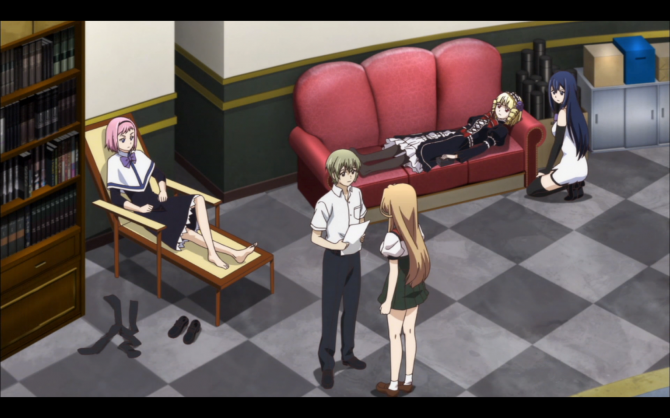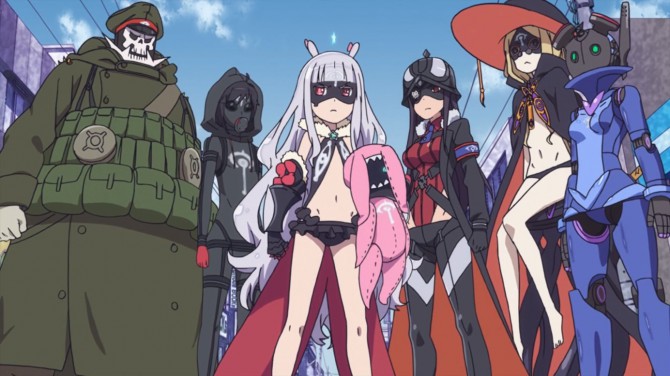January 5th, 2015 in Anime, Black Bullet, General Reviews by The Droid

This is another of those “Girls Who Save the World” shows, but with a bit more tragic results, potentially closer aligned to “Gunslinger Girl”. Welcome to the world of “Black Bullet”.
It is the year 2021. Mankind has been decimated by the Gastrea, a parasitic virus, and is forced to live within this ring of Monoliths, which are created from Varanium: a metal that is able to subdue Gastrea. (And where did we discover this metal?) Soon, children are born with the Gastrea virus. They have superhuman abilities as a result, but people are so terrified of them, they are dubbed “Cursed Children”. Because the Gastrea threat is still out there, the Cursed Children (who are all girls) fall under the jurisdiction of the Civil Securities. You now have a pair of fighters: the Initiator, (the child) and a Promoter, (the guy). We follow the adventures of Rentarō Satomi (the guy with the gun), a high school student who is also a Promoter in Tendō Civil Security Agency owned by his childhood friend Kisara Tendō, along with his Initiator, Enju Aihara (red head), who try to prevent the destruction of the Tokyo Area and the world.
OK, so we will take a break so you can take this all in. It’s quite a lot. (more…)
Tags: Action, Mystery, Sci-Fi, Seinen
December 28th, 2014 in Anime, General Reviews, Nanana’s Buried Treasure by The Droid

“Nanana’s Buried Treasure” (“Ryūgajō Nanana no Maizōkin”) is a good action-adventure-ghost show, as there are layers upon layers and everyone has a hidden agenda. Oh, and this also is a “move-in” show.
Our hero, Juugo Yama, (fourth from left) comes to the “Special Student Zone” on the artificial island Nanaejima. Strapped for funds, he moves into an apartment, with the strange proviso of all the rent for a year up front. The reason? It is haunted by a previous tenant who was murdered there. This is Nanana (the one in the trunk) and she spent her living days hunting down strange and unusual treasures.
It has been 10 years since she was killed and the cops are no closer to finding her murderer today than when it happened. Juugo is determined to find her killer, but also unlock the hidden treasures that are about the island. Part of this is to help her move on. Another is the lure of treasure. Now, for a ghost, Nanana is both lively (playing video games all the time) and hungry (devouring pudding, but preferring a rather expensive brand). And when she wishes it, can physically manifest herself (as she wrestles Juugo often for apartment supremacy). (more…)
Tags: Comedy, School, Supernatural
December 21st, 2014 in Anime, Brynhildr in the Darkness, General Reviews by The Droid

This can be properly categorized as a ‘witch show’, but this is no ‘magical girl’ show. It might be closer aligned with “Black Rock Shooter” in the caliber of despair that it generates, but I get ahead of myself. This is an unhappy show. Not a sad show. A sad show is like “Air the Series” or “5 Centimeters per Second”. This one is unhappy is that everyone…it looks like I’m taking the chute back to Square One, as I’m getting ahead of myself.
“Brynhildr in the Darkness” (“Gokukoku no Buryunhirude” “Extreme-Black Brynhildr”) is an odd cat of a story, mainly because it doesn’t know what it wants to be.
Ryouta Murakami is head of the astronomy club. They even have this far out observatory to use. (No, I mean far out; he has to take a couple of bus lines to get to the thing) Too bad there isn’t a single other person in the club. I mean, what gives? I know if there was an astronomy club at my high school, I’d be there (we had a chess club. If I had joined, I’d be called ‘Carpet’, as I’d have been laid out the entire time.) (more…)
Tags: Drama, Fantasy, Harem, Mystery, Sci-Fi, Seinen
December 16th, 2014 in Anime, Engaged to the Unidentified, General Reviews by The Droid

In a sense, this is another ‘move-in’ show, but it takes a slightly different tack for it. “Engaged to the Unidentified” (“Mikakunin de Shinkōkei”, “Unconfirmed & In-Progress”) tells the tale of Kobeni Yonomori (far left). She is a high school girl who lives with her mother and older sister Benio (next to her). Upon turning sixteen, Kobeni is shocked to learn that, due to an arrangement by her late grandfather, she is engaged to a boy named Hakuya Mitsumine (far right) who, along with his little sister Mashiro, (next to him) come to live with Kobeni. Talk about a move in, they not only come into the house, they come into the school and right into her class room (like you didn’t see that one coming, eh?). As Kobeni spends time adjusting to this new family, she learns there is more to Hakuya and Mashiro than meets the eye.
Kobeni has enough problems in her life, as sister Benio is The Most Popular Person at School, smart as they come, Student Council President, perhaps runs the World Bank in her spare time and anyone would do anything for her. It’s that now we have Hayuka transfer in (a man of little to no words) and Mashiro (who is a bit overcute for me. Look, look, her uniform is too large so you never see her hands! Awwwwwww!) In a sense, Kobeni is under attack on three fronts and has to place this all in perspective. Adding to the concerns, she kind of vaguely remembers Hayuka, but a childhood accident robbed her of her memories of that time. (more…)
Tags: Comedy, Romance, Slice of Life
December 14th, 2014 in Anime, General Reviews, World Conquest Zvezda Plot by The Droid

This is one strange fish of a show, in the fact I think it is intentionally designed not to make any sense. “World Conquest Zvezda Plot” (“Sekai Seifuku: Bōryaku no Zvezda”) confuses you right from the start, as the entire series is told as a giant flashback.
We are greeted with a scene of absolute destruction and devastation. Is anyone left alive? Is the Starbucks razed? A lone figure wanders the shattered landscape, pondering the nature of world conquest and the people who do it. We are then transported back in time, to when things were sunny and clean and colorful and it all worked (sort of). Oh, and there IS a Starbucks.
Asuta Jimon (he’s that S&M looking type, second from left) has run away or been thrown out of his house by his father. As he walks the streets, he is told to get inside fast, as marshal law is being declared. He flees the police and ducks into an alley, where he meets Kate Hoshimiya, (dead center) who is looking for her doll (yeah, that hideous pink bunny. Those are pointed teeth). She also calls herself Lady Venera, the leader of Zvezda, an organization with its eyes on world conquest. Asuta is eventually cornered by the military, but is rescued by Kate, who welcomes him to her group. (more…)
Tags: Action, Comedy, Fantasy
December 8th, 2014 in Anime, Blue Exorcist, General Reviews by The Droid

The title for this show is a tad misleading, in that “Blue Exorcist” does not approach exorcism as you think it should. Sure, these folks get rid of demons, but they do not necessarily possess people as much as they are free-form rovers that cross over and need to be sent off to the afterlife.
We start off the show with Rin and Yukio Okumura (second from left and far right, both in front row) and their overseer Father Shiro Fujimoto (the guy with the cross eyeglass danglers). They learn that they are both the son of Satan, but it appears that Rin inherited all the power. Father is an exorcist and has been taking care of them since they were born. Well, since they are both now teens, they get those yearnings and itches…..to be on their own! What did you think I meant, pervert? However, Rin rebels against Father at a bad time and Father gets possessed by Satan, who is looking for an earthly vessel. Father takes care of that matter, but not in the best way for everyone involved.
It is determined that Rin and Yukio should go to True Cross Academy, to learn how to become a real exorcist. The school is taken care of by Chairman Mephisto Pheles (that really happy dude in the back row), but he’s a bit of a jerk. That’s the biggest problem with the series: everyone is a caliber of jerk. In any case, he takes a special exorcist course, where he meets other people who want to become exorcists. The rest of the classmates, from left to right are (more…)
Tags: Action, Demons, Fantasy, Shounen, Supernatural
December 4th, 2014 in Anime, Black Lagoon, General Reviews by The Droid

“Black Lagoon” is really a fine series, but understand that it is grim and gritty and violent and unrelenting, reminding me of series like “Gantz” and “Deadman Wonderland”, only not as graphic with the violence or destruction, but still with disturbing concepts and approaches.
Our ‘hero’ (for lack of a better term; this anime is like “Payback”, where everyone is horrible, just varying degrees of it) is Rokuro Okajima, the decent-looking one up there. He works for the Asahi Company, who sent him out on a ‘project’. The ship he was on got hijacked and he was taken hostage, but the company wrote him off, not willing to do anything to save him. Since his options were to either sleep with the fishes or boat over them, he chose the latter and made “Black Lagoon” a quartet.
Yes, they are all mercenary pirates who will do anything for a buck and they prove their mettle. The rest of the company consists of (left to right) Benny (Lagoon Company’s mechanic, computer specialist, and researcher. He also functions as the Lagoon’s driver), Revy (Rebecca Lee, chief killer and trigger girl) and Dutch (CEO, for want of a better term and ex-Marine). They operate out of the Asian city of Roanapur, a completely lawless and corrupt city, where anything can be obtained for a price and the cops appear to act more as clean-up than clean-out. (more…)
Tags: Action, Seinen
December 1st, 2014 in Anime, General Reviews, My Neighbor Seki: The Master of Killing Time by The Droid

“My Neighbor Seki: The Master of Killing Time” (“Tonari no Seki-kun”) manages to pack a lot of story into a brief amount of time (each episode is about eight minutes long) and it tells the story about this guy, Toshinari Seki, who spends his class time not learning anything, and doing other, non-academic, things as well. Because he is in the far back right desk (near the window, last row), the teacher never sees his elaborate games and ‘experiments’ he does, rather than him learning about history or math.
The young lady, Rumi Yokoi, is doing her best to study and learn, but Seki is so elaborate in what he is doing, she cannot help but get sucked into his schemes. She rarely participates, but she gets emotionally overwrought with the events on the desk next to her and neglects her class work as well.
This is one goofy show, and I had a lot of fun with it. You may be less interested in what he is doing and more how he is able to pull it off. This guy’s talents are wasted at school, but he can’t get anyone to notice his efforts. And the sub-story with the Gundam Family (Papa GFR, Mama GFR and Child GFR) takes on soap opera caliber involvement, not only with their personal tales, but how Rumi wonders what will happen to them in the bigger scheme of things. (more…)
Tags: Comedy, School, Seinen
November 24th, 2014 in Anime, General Reviews, The Comic Artist and Assistants by The Droid

This is a slightly longer short-pull show, in that the episodes are about 15 minutes each. “The Comic Artist and Assistants” (“Mangaka-san to Ashisutanto-san to”) tells the tale of Yūki Aito, who is a manga writer and artist. But he has problems, in that he is always pushing deadlines for his currently serialized “Hajiratte Cafe Latte” story, and so he is given help with assistants, who at least do the inking to speed things along.
His ‘staff’, as it were, consists of (left to right):
Mihari Otosuna, Yūki’s editor, often scolding and beating him for his shortcomings. She and Yūki were once classmates.
Sahoto Ashisu, 19 year old assistant. Serious on her own work ethic yet very down-to-earth. She is often the target of Yūki’s mischief.
Sena Kuroi, also 19. Due to her small, childish stature, Sena is usually mistaken as a child and, at times, acts like one, especially when she is drunk.
Rinna Fuwa, again 19. Despite being an assistant, Rinna knows nothing about drawing manga, as she was hired by Mihari due to Yūki wanting someone who is cute. (more…)
Tags: Comedy, Ecchi, Harem, Seinen, Slice of Life
November 20th, 2014 in Anime, General Reviews, One Week Friends by The Droid

Do you remember the movies “50 First Dates” or “Blank Slate”? These films involved people with some kind of mental aberration that causes them to forget what had happened during the day. This offering, “One Week Friends” (“Isshūkan Furenu”) is a bit different, as she resets every week.
Because of this affliction, Kaori Fujimiya, (Madame Profile) does not make friends, as she cannot honestly remember who they are and so it gives the impression that she is stand-offish or conceited or rude, so she stays by herself. Into her life come Yūki Hase (The Sweater), who wants to be her friend, but doesn’t understand her situation. He slowly comes to figure out a way that she doesn’t forget people that she met and things she did during the week, but suggests that she keeps a diary of what she did during that time, aided by a poster in her room to remind her to read her journal every Monday. (more…)
Tags: Comedy, School, Shounen, Slice of Life









